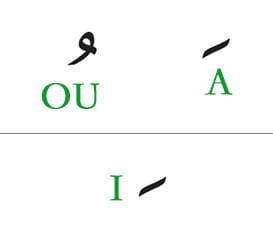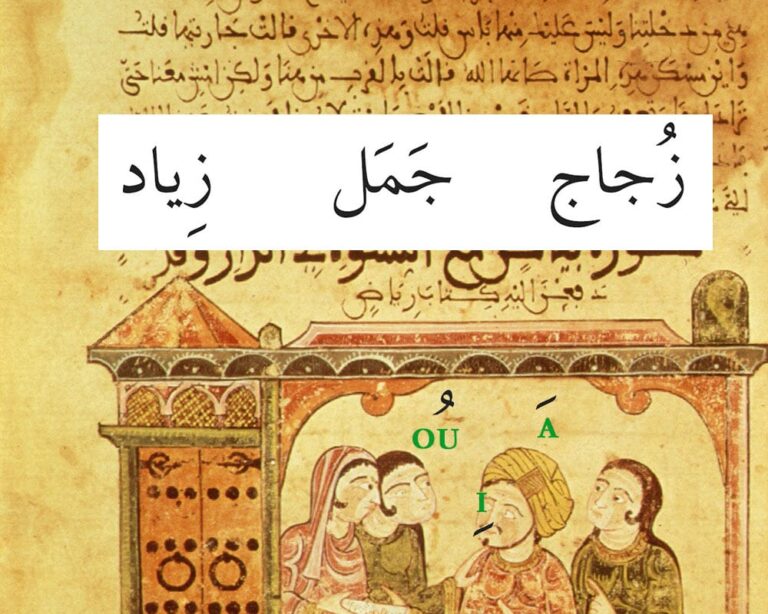This is undoubtedly one of the most unsettling things about learning Arabic: the absence of vowels. As I mentioned in the first lesson, most vowels are not written in standard Arabic texts.
In fact, we don’t really have any vowels in the Arabic alphabet, at least not in the sense that we, users of the Latin alphabet understand it.
The three vowels of the Arabic alphabet
In all European languages, we have several vowels, traditionally ‘a, e, i, o, u’, accents (é or è in French, ü or ö in German) which modify the vowel sound or not at all (ù), and ‘compound vowels’, diphthongs, ai, io, or …. plus, somewhere, a letter, the y, which will help us to understand vowels in Arabic. The y is not one of our traditional vowels, yet it is an ‘ii’ sound, and therefore a vowel.
In Arabic, there are only three vowels: Alif ا , which is more of an ‘A’ sound, Ya ي , which is more of an ‘i’ sound, and Waw و , which is more of an ‘Ou’ sound. But these are long vowels. Short vowels aren’t worth writing (basically). So we mark them with little signs that change the pronunciation of the consonant (these are diacritical marks, if you want to know what they are you can click on the arrow to see the definition. But it’s not necessary for the rest of the lesson).
And the Ha? Well, it’s not a vowel, because it also marks a little glottal sound, a very slight stop.

These are the three signs:
- a small slash above the letter, for the ‘A’ sound (called the fatha – فَتْحَةٌ )
- a small slash below the letter, for the ‘I’ sound (called the kasra – كَسْرَة )
- and for the ‘Ou’ sound, a small miniature Waw above the letter (called the damma – ضَمَّة )
How can I remember them easily?
- the fatha is an elongated Alif
- the kasra is the two points of the Ya that have been joined together
- and the damma, too easy because it looks so much like the Waw.
These vowels are still used in religious texts, where it is essential not to change ‘one letter’ of the divine word.
Apart from that, they are very rarely used in everyday life. Even on my marriage contract, which is a very official document on which there should be no mistakes, there are no such little signs. You can also use them ‘from time to time’, when it’s essential to clear up an ambiguity, but most of the time, people do without them.
Here’s what vocalised words look like:

The first is زُجاج , the glass. The damma is clearly visible, and as the is not ‘vocalised’, it is pronounced A. This gives
The second is جَمَل which is pronounced which means ‘the camel’. But with a final damma , الجملُ , it becomes ‘sentences, punishments’ . And if, instead of using a short vowel with the fatha, we use a long A, i.e. an Alif, then we have جمال which means ‘beauty’ and is the origin of the two first names Djamel and Djamila and
The third is a first name, Ziyad . It has two vowels and a kasra, and is pronounced as follows . It therefore begins with an i because of the short kasra, then an unvoiced ي , ya, followed by an unvoiced ا , a:
The Tanwin – تَنْوينٌ
You don’t really think you’re going to get away with this, with three little signs you can learn in a minute, do you? We said ‘ten minutes a day’.
Tanwin is the doubling of vocalisation. We’ll write two kasra, for example, one under the other, like this: ٍ .
But there’s a catch! It doesn’t mean that we’re pronouncing two i’s in a row, no, but that we’re going to add an n. ‘in’. So a نٍ with two kasra one under the other is pronounced nin.
To write the vowels or not?
In fact, I’d recommend that you try to learn to read and write without vocalisation straight away. In most Arabic courses, you start by learning with the vowels, only to give up after a month or two. But maybe it’s better to learn right away ‘without the vowels’ (at least, I prefer it, because I don’t get tangled up). Much later, when you have a good command of Arabic, if you’re interested in Quranic Arabic, then you can learn all the subtleties of vocalisation (and there are many).
 A typo or syntax error? You can select the text and hit Ctrl+Enter to send us a message. Thank you! If this post interested you, maybe you can also leave a comment. We'd love to exchange with you !
A typo or syntax error? You can select the text and hit Ctrl+Enter to send us a message. Thank you! If this post interested you, maybe you can also leave a comment. We'd love to exchange with you !




